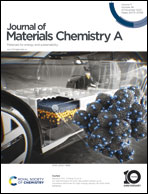Tribovoltaic effect promotes highly efficient direct current generator†
Abstract
Currently, extremely high voltage output has been achieved by a direct current triboelectric nanogenerator (DC-TENG) based on semiconductor–semiconductor interfaces. DC-TENGs with metal–semiconductor interfaces are highly anticipated due to their potential advantages such as low cost, simpler structures, lower internal resistance, and wide selection of materials. Herein, we propose a DC-TENG with a metal–polymer–semiconductor interface and a dynamic Al/PVP/Si heterojunction, which produces a peak voltage of 26 V and exhibits a 5-fold improvement over reported Schottky DC-TENGs because the polyvinylpyrrolidone greatly increases the surface state density of silicon. During the reciprocating friction of the aluminum foil on the silicon substrate, the internal junction current generated by the directional movement of non-equilibrium carriers induced by friction always flows from Al to silicon, independent of the type of silicon, and thus can be used in self-powered electronic devices for continuously converting mechanical energy into electrical energy. Moreover, by introducing conventional dielectric polymer materials, a DC-TENG can be prepared as a dual-mode TENG for application in self-powered sensing. Our work presents for the first time the tribovoltaic effect at the metal–polymer–semiconductor interface, which may inspire further research on Schottky DC-TENGs and accelerate their practical application in self-powered systems.

- This article is part of the themed collection: Journal of Materials Chemistry A HOT Papers


 Please wait while we load your content...
Please wait while we load your content...